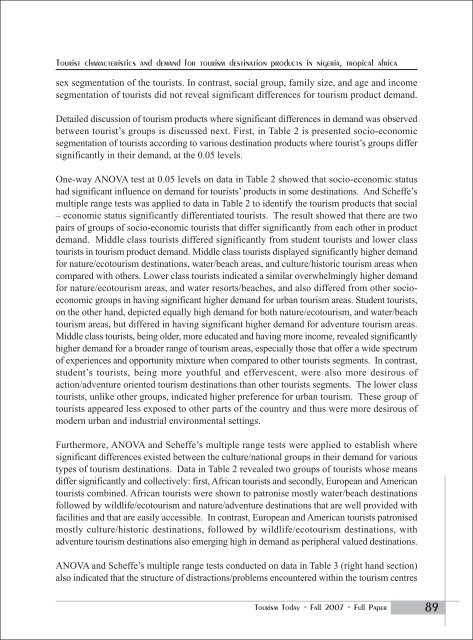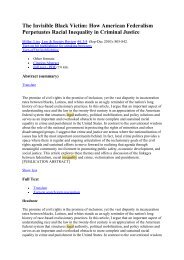Ski – resort and regional development: profile of visitors ... - E-Journal
Ski – resort and regional development: profile of visitors ... - E-Journal
Ski – resort and regional development: profile of visitors ... - E-Journal
Create successful ePaper yourself
Turn your PDF publications into a flip-book with our unique Google optimized e-Paper software.
Tourist characteristics <strong>and</strong> dem<strong>and</strong> for tourism destination products in nigeria, tropical africa<br />
sex segmentation <strong>of</strong> the tourists. In contrast, social group, family size, <strong>and</strong> age <strong>and</strong> income<br />
segmentation <strong>of</strong> tourists did not reveal significant differences for tourism product dem<strong>and</strong>.<br />
Detailed discussion <strong>of</strong> tourism products where significant differences in dem<strong>and</strong> was observed<br />
between tourist’s groups is discussed next. First, in Table 2 is presented socio-economic<br />
segmentation <strong>of</strong> tourists according to various destination products where tourist’s groups differ<br />
significantly in their dem<strong>and</strong>, at the 0.05 levels.<br />
One-way ANOVA test at 0.05 levels on data in Table 2 showed that socio-economic status<br />
had significant influence on dem<strong>and</strong> for tourists’ products in some destinations. And Scheffe’s<br />
multiple range tests was applied to data in Table 2 to identify the tourism products that social<br />
<strong>–</strong> economic status significantly differentiated tourists. The result showed that there are two<br />
pairs <strong>of</strong> groups <strong>of</strong> socio-economic tourists that differ significantly from each other in product<br />
dem<strong>and</strong>. Middle class tourists differed significantly from student tourists <strong>and</strong> lower class<br />
tourists in tourism product dem<strong>and</strong>. Middle class tourists displayed significantly higher dem<strong>and</strong><br />
for nature/ecotourism destinations, water/beach areas, <strong>and</strong> culture/historic tourism areas when<br />
compared with others. Lower class tourists indicated a similar overwhelmingly higher dem<strong>and</strong><br />
for nature/ecotourism areas, <strong>and</strong> water <strong>resort</strong>s/beaches, <strong>and</strong> also differed from other socioeconomic<br />
groups in having significant higher dem<strong>and</strong> for urban tourism areas. Student tourists,<br />
on the other h<strong>and</strong>, depicted equally high dem<strong>and</strong> for both nature/ecotourism, <strong>and</strong> water/beach<br />
tourism areas, but differed in having significant higher dem<strong>and</strong> for adventure tourism areas.<br />
Middle class tourists, being older, more educated <strong>and</strong> having more income, revealed significantly<br />
higher dem<strong>and</strong> for a broader range <strong>of</strong> tourism areas, especially those that <strong>of</strong>fer a wide spectrum<br />
<strong>of</strong> experiences <strong>and</strong> opportunity mixture when compared to other tourists segments. In contrast,<br />
student’s tourists, being more youthful <strong>and</strong> effervescent, were also more desirous <strong>of</strong><br />
action/adventure oriented tourism destinations than other tourists segments. The lower class<br />
tourists, unlike other groups, indicated higher preference for urban tourism. These group <strong>of</strong><br />
tourists appeared less exposed to other parts <strong>of</strong> the country <strong>and</strong> thus were more desirous <strong>of</strong><br />
modern urban <strong>and</strong> industrial environmental settings.<br />
Furthermore, ANOVA <strong>and</strong> Scheffe’s multiple range tests were applied to establish where<br />
significant differences existed between the culture/national groups in their dem<strong>and</strong> for various<br />
types <strong>of</strong> tourism destinations. Data in Table 2 revealed two groups <strong>of</strong> tourists whose means<br />
differ significantly <strong>and</strong> collectively: first, African tourists <strong>and</strong> secondly, European <strong>and</strong> American<br />
tourists combined. African tourists were shown to patronise mostly water/beach destinations<br />
followed by wildlife/ecotourism <strong>and</strong> nature/adventure destinations that are well provided with<br />
facilities <strong>and</strong> that are easily accessible. In contrast, European <strong>and</strong> American tourists patronised<br />
mostly culture/historic destinations, followed by wildlife/ecotourism destinations, with<br />
adventure tourism destinations also emerging high in dem<strong>and</strong> as peripheral valued destinations.<br />
ANOVA <strong>and</strong> Scheffe’s multiple range tests conducted on data in Table 3 (right h<strong>and</strong> section)<br />
also indicated that the structure <strong>of</strong> distractions/problems encountered within the tourism centres<br />
Tourism Today - Fall 2007 - Full Paper<br />
89














